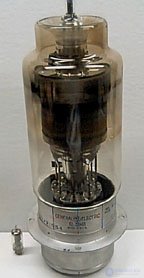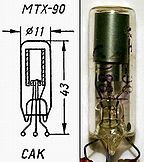Lecture



A tiratron is an ionic (gas-discharge) device for controlling electric current using voltages applied to its electrodes. It is a sealed cylinder filled with gas, in which at least three electrodes are placed. Inert gases, hydrogen or mercury vapors are used for filling. The electrodes of the thyratron are called the anode, cathode, and grid. The electrode grid is located in the cylinder between the anode and the cathode, it is used to ignite the gas discharge in the space between the anode and the cathode. The space between the anode and the cathode serves to hold an ionized gas that conducts electrical current. To perform more complex functions than switching on and off electric current, thyratrons can have two or more grids. Depending on the number of nets, the thyratrons are called: one - triode, two - tetrode, three or more - pentode, hexode. In the simplest thyratron, a triode, the discharge is ignited when a positive voltage of a certain value is applied to the grid. If at the same time the voltage on the anode is positive with respect to the cathode, then the gas between the anode and the cathode ionizes and begins to conduct. Unlike vacuum triodes, when removing the control voltage on the grid, the current between the anode and cathode does not break until the voltage at the anode decreases below the voltage to maintain the discharge (does not become, roughly speaking, negative). It is conditionally accepted to divide thyratrons according to their intended purpose into low-powered and powerful ones. Low-power thyratrons are designed to indicate and perform logic functions in automatic devices. Powerful thyratrons are designed to control large currents in power supply and electric drive devices. In modern electronics, low-power thyratrons are rarely used; they are almost completely superseded by semiconductor devices. Modern high-power thyratrons are used for switching current pulses up to 10 kA and voltages up to 50 kV.
In glow discharge thyratrons, a current passes through a gas ionized by a glow discharge. The thyratron balloon is filled with a mixture of inert gases (the glow zener diode has the same filling). The anode is made in the form of a metal cylinder, inside which there is a cathode in the form of a loop of thin wire with a special coating that facilitates the ignition of the gas discharge. A metal cylinder of a smaller diameter, which acts as a grid, is put on the cathode (the MTX-90 design of the thyratron is shown in the illustration). Such thyratrons do not require heating the cathode, so they have another name - cold cathode thyratrons. Glow discharge thyratrons are low-power thyratrons. They are used in automatic devices for indicating (from single control lamps to matrix analog-digital panels with dynamic control) and performing logic functions. Special combinations of control electrodes and gas discharge tubes make it possible to implement logic functions AND, OR, BAN, pulse delay on the thyratron. Regardless of the design, any thyratron can operate as a memory cell, indicator, current amplifier (key) and signal normalizer.
Thyratrons differ in the method of applying a control signal (method of ignition)
and
In the domestic TV-sets of the LT-47-III series, glow-discharge thyratrons of the ТХ4Б type were used as the master oscillator of the cadre sweep. Unfortunately, the design of this unit was unsuccessful, which led to unreliable personnel synchronization with a slight deterioration of the cathode of the thyratron. This has led developers to abandon the thyratron in favor of circuits on electronic tubes. For repair of TVs with thyratrons, changes in the scheme developed by radio amateurs were sometimes used, which increased the stability of the personnel scan when the thyratron was worn.
Indicator thyratrons are a special class of glow discharge thyratrons, intended, as their name implies, not so much for switching electrical circuits, as for indication. Unlike simple neon lamps, they are able to be controlled by reduced voltages, as well as to remember their state, unloading the computing system that controls them to perform other tasks. Some indicator thyratrons are luminophore and make it possible to obtain colors different from those characteristic of neon orange-red.
Although nothing prevents you from using practically any suitable glowing thyratron suitable for the parameters, made in a transparent cylinder, the use of special, indicator thyratrons in this quality allows you to get significantly better ergonomic and aesthetic indicators.
Domestic indicator thyratrons are represented by the models: MTX-90 - three-electrode (this thyratron is still used in railway automation devices in time blocks BVMSh and BSVSH, as an active element of a relaxation generator in devices for automatic periodic operation of stroboscopes on a pulsed lamp, in high voltage generators some air ionizers, as a light source and at the same time an active element of a relaxation generator in phototherapy devices , In sensor devices, wherein it opens when exposed to net crosstalk from touching the finger to the sensor connected to the grid through a resistance of 1 megohm (presence of this resistance must!), Etc.), TH5B -. Chetyrohelektrodny, TH16B - five-electrode, TH17B - five-electrode green phosphor, ТХ18А - three-electrode, ТХ19А - six-electrode phosphor, there is in variants ТХ19АЖ - yellow, ТХ19АЗ - green, ТХ19АК - red, ТХИ2С - four-electrode, ITS1 - seven-segment luminophore (TCI2C - four-electrode, ITS1 - seven-segment luminophoric with memory function status of each segment on the basis of the thyratron.
These thyratrons have another name - arc discharge thyratrons. In contrast to glow discharge thyratrons (cold cathode thyratrons), hot cathode thyratrons have a cathode heated by an electric current. The working medium of thyratrons is gas, mercury vapor, a mixture of gases, a mixture of gases and mercury vapor. Neon, xenon, krypton-xenon mixture, argon-mercury mixture or mercury vapor are used. The gas discharge in thyratrons belongs to the class of arc discharges. In this case, the arc discharge occurs under reduced pressure and is maintained by thermionic emission from the cathode. Thyratrons use a cathode of direct heat of a tape structure (made of metal tape). The location of the tape turns is chosen so that the flow of gas ions is directed parallel to the surface of the tape. This technique is used to protect the cathode surface from destruction by gas ions. The supply voltage for heating the cathode is selected low (up to five volts) because at higher voltages the gas discharge in the cylinder can be ignited between the cathode terminals. This phenomenon is called cathode breakdown.
Thin cathode thiratrons belong to the category of powerful thyratrons and are used to control large currents. Previously, they were widely used in industrial electronics and electric transport in circuits of controlled rectifiers and power switches. At present, the heated cathode thyratrons are almost completely superseded by thyristors performing the same functions. In addition, high-power thyratrons usually filled with mercury vapor, and now the use of such devices is prohibited. Now, powerful thyratrons are produced with hydrogen filling and are used to control very large currents at high voltages (in such conditions, thyristors are not capable of working). An example of such a thyratron is the powerful thyratron shown in the photograph.
Plasma OJSC, which is part of the Roselectronica holding, is one of the oldest enterprises in Russia and the former USSR engaged in the development and production of tiratrons. A new type of activity was mastered at Plasma OJSC in 1960. [one]
Most of the thyratrons produced on "Plasma" have a tetrode structure, which allows to achieve a high stability of the discharge development time and an increased switching speed.
At the moment, Russian thyratrons are used to modulate and switch power in radar (TGI3-500 / 16 model), to generate shock excitation in radar (TGI1-3000 / 30 model) and for use in CO2, nitrogen, metal vapor and excimer lasers (TGI2-1000 / 25, TGI2-500 / 20 models). [2]
Comments
To leave a comment
Radio tubes and ion devices
Terms: Radio tubes and ion devices